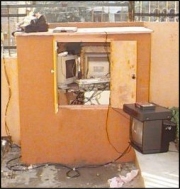Beginnings
Dr. Sugata Mitra, Chief Scientist at NIIT, is credited with the discovery of Hole-in-the-Wall. As early as 1982, he had been toying with the idea of unsupervised learning and computers. Finally, in 1999, he decided to test his ideas in the field. On 26th January, Dr. Mitra's team carved a "hole in the wall" that separated the NIIT premises from the adjoining slum in Kalkaji, New Delhi. Through this hole, a freely accessible computer was put up for use. This computer proved to be an instant hit among the slum dwellers, especially the children. With no prior experience, the children learnt to use the computer on their own. This prompted Dr. Mitra to propose the following hypothesis:
The acquisition of basic computing skills by any set of children can be achieved through incidental learning provided the learners are given access to a suitable computing facility, with entertaining and motivating content and some minimal (human) guidance.
Encouraged by the success of the Kalkaji experiment, freely accessible computers were set up in Shivpuri (a town in Madhya Pradesh) and in Madantusi (a village in Uttar Pradesh). These experiments came to be known as Hole-in-the-Wall experiments. The findings from Shivpuri and Madantusi confirmed the results of Kalkaji experiments. It appeared that the children in these two places picked up computer skills on their own. Dr. Mitra defined this as a new way of learning - Minimally Invasive Education.
At this point in time, International Finance Corporation joined hands with NIIT to set up Hole-in-the-Wall Education Limited (HiWEL). The idea was to broaden the scope of the experiments and conduct research to prove and streamline Hole-in-the-Wall. As part of this, more than 30 such clusters of computers or, as they have come to be known, Learning Stations have been set up in India and outside India. The results, which have been uniformly encouraging, show that children learn to operate as well as play with the computer with minimum intervention. They picked up skills and tasks by constructing their own learning environment.
About the man
Dr. Sugata Mitra is a long-term educationist and a scientist of international repute. He has over 25 inventions and first-time applications in the areas of Cognitive Science, Information Science and Education Technology, to his credit. Dr. Mitra has been the Chief Scientist at NIIT and is currently Professor of Educational Technology at Newcastle University, UK.
Dr. Mitra is a winner of "Man of Peace Award" from Together for Peace Foundation, USA, and "Social Innovation Award" from Institute of Social Inventions, UK. He was also conferred the "Dewang Mehta Award" by the Government of India in recognition for his work related to Hole-in-the-Wall.
About NIIT
NIIT, the global IT Learning Solutions Corporation, is known for its pioneering work in the field of IT education and training. Its strong research orientation has helped it to continuously innovate in the areas of instructional design methodologies, and curricula development that is cutting-edge.
NIIT's vast education delivery network spread across 33 countries in the Americas, Europe, Asia, Middle East, Africa and Australia/Oceania, blends classroom and on-line learning. The company provides a comprehensive education environment to individuals and enterprises; offering training that is customized to the varied needs of audiences with diverse backgrounds.
To learn more about NIIT, visit http://www.niit.com/
|
 |
About HiWEL |
 |
Beginnings |

The very first Learning Station at Kalkaji - rear view.
|
|

The opening day of the Learning Station at Shivpuri.
|
|




